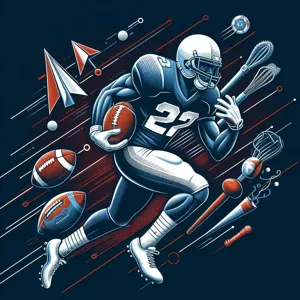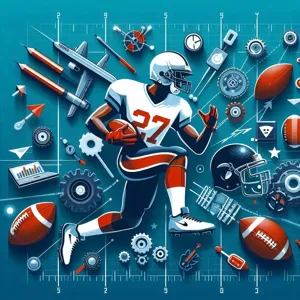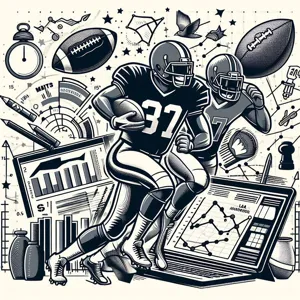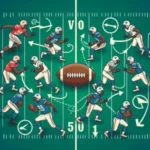In the high-octane world of American football, wide receivers are often the unsung heroes of the game, embodying the perfect blend of agility, speed, and strategic thinking.
As the players who bridge the gap between the quarterback and the end zone, their role is pivotal in turning the tide of a game. But what exactly does it take to excel in this dynamic position? From mastering the art of precise route running to developing an unshakeable hand-eye coordination for those nail-biting catches, wide receivers must cultivate a diverse set of skills to thrive on the field. In this blog post, we’ll delve into the essential skills every aspiring wide receiver needs to hone, exploring the techniques, training methods, and mental fortitude required to catch success and make unforgettable plays that can lead their team to victory. Whether you’re a player looking to elevate your game or a fan eager to understand the intricacies of this thrilling position, join us as we break down the keys to becoming a standout wide receiver in American football.
1. Introduction to the Role of a Wide Receiver

The role of a wide receiver in American football is both exhilarating and demanding, blending athleticism with strategic acumen. As the players tasked with stretching the field and creating scoring opportunities, wide receivers are often seen as the game’s playmakers. Positioned on the outer edges of the offensive formation, these athletes must possess a unique combination of speed, agility, and precise route-running skills to evade defenders and create separation.
However, being a wide receiver involves much more than just catching passes. It requires a keen understanding of the game, including the ability to read defenses and anticipate the quarterback’s decisions. A successful wide receiver must also have impeccable hand-eye coordination and the ability to make split-second adjustments mid-play. From executing crisp routes to securing catches in traffic, wide receivers are under constant pressure to perform.
Moreover, their role extends beyond individual performance. Communication and chemistry with the quarterback and offensive line are crucial; a deeper understanding of the overall offensive strategy can make the difference between a missed opportunity and a game-changing touchdown. In essence, the wide receiver is a multifaceted position that not only demands physical prowess but also mental sharpness and teamwork, making it a vital cog in the machinery of American football. As we delve deeper into the essential skills needed for success in this role, it becomes clear that a wide receiver’s impact on the game is profound and far-reaching.
2. The Importance of Speed and Agility
In the fast-paced world of American football, speed and agility are not merely advantageous; they are essential for a wide receiver’s success on the field. Imagine a game characterized by split-second decisions and rapid movements; it’s a dance of athleticism that requires receivers to be both quick and nimble. Speed allows a wide receiver to create separation from defenders, ensuring they can get open for that critical catch. The ability to sprint down the field at lightning speed can make the difference between a touchdown and a turnover, turning a potential loss into a spectacular gain.
But speed alone isn’t enough. Agility complements that burst of speed, enabling receivers to navigate through defenders and change direction rapidly. This skill is crucial when it comes to executing sharp cuts and precise routes. A wide receiver must possess the ability to make sudden lateral movements, pivoting on a dime to shake off defenders while maintaining their speed. It’s the combination of these two skills that allows wide receivers to perform dazzling moves like the hitch-and-go or the double move, leaving defenders in their wake and creating opportunities for big plays.
Training to enhance speed and agility involves a variety of drills and exercises, from sprinting and shuttle runs to ladder drills that improve footwork and coordination. Strength training also plays a vital role in building the muscle required for explosive movements. By developing these skills, wide receivers not only improve their performance but also increase their confidence on the field. When they know they can outpace and outmaneuver their opponents, they can focus on running their routes and making those game-changing catches. Ultimately, speed and agility are not just traits; they are the lifeblood of a wide receiver’s game, allowing them to seize every opportunity and contribute to their team’s success.
3. Mastering Route Running Techniques

Mastering route running techniques is a fundamental skill that separates exceptional wide receivers from the rest of the pack. Route running isn’t just about speed; it’s about precision, timing, and understanding the nuances of the game. A wide receiver must be able to create separation from defenders, and that starts with a well-executed route.
At its core, effective route running combines a deep understanding of various routes—such as slants, curls, go routes, and outs—with the ability to read the defense. A receiver needs to know how to adjust their route based on the coverage they are facing. For instance, against a press coverage, a quick burst off the line of scrimmage and a sharp cut can allow them to shake off their defender. Conversely, against zone coverage, finding the soft spots and sitting in the open areas is essential.
Footwork plays a pivotal role in route running. Receivers must develop agile footwork to make quick cuts and maintain their speed while changing direction. Drills focused on foot speed, agility, and quickness are crucial for honing this skill. Practicing routes repetitively helps internalize the movements, allowing for muscle memory to take over during crucial game situations.
Moreover, timing with the quarterback is just as important as the route itself. A wide receiver must sync their breaks with the quarterback’s dropback to ensure the ball arrives at the right moment. This chemistry can often be the difference between a completed pass and an interception.
Lastly, studying film is a powerful tool for mastering route running. By analyzing their own performance and that of successful receivers, players can identify areas for improvement and learn new techniques to incorporate into their game. In a sport where every millisecond counts, mastering route running techniques is not just a skill; it’s an art that can elevate a wide receiver’s game to the next level, making them an indispensable asset to their team’s offense.
4. Fundamentals of Catching the Football
Catching the football is a fundamental skill that can make or break a wide receiver’s performance on the field. It’s not just about having quick hands; it requires a combination of technique, focus, and finesse. The first step in mastering the art of catching is to ensure that you’re in the right position. A wide receiver must maintain a balanced stance, with knees slightly bent and feet shoulder-width apart, allowing for quick bursts of speed and agility.
Once in position, the key to a successful catch lies in the “diamond” technique. This involves forming a diamond shape with your hands—thumbs and index fingers coming together—when intercepting a ball thrown your way. This technique provides a secure grip while ensuring you can absorb the impact of the ball, whether it comes in high, low, or at varying speeds.
Moreover, eye coordination is crucial. A receiver must track the ball from the quarterback’s hand to its final destination. This means keeping your eyes locked on the ball and anticipating its trajectory, allowing you to adjust your body as needed. Practicing with a partner or using a rebounder can refine this skill, enhancing hand-eye coordination and reaction times.
Finally, mental preparation plays a vital role. A successful catch isn’t just about physical ability; it’s also about confidence and focus. Wide receivers often face intense pressure, and developing a positive mindset can help them stay calm under fire. Visualizing successful catches in practice can translate that confidence into games, allowing receivers to perform at their best when the stakes are high. By honing these fundamentals, wide receivers can elevate their game, ensuring they are not just effective but also reliable targets for their team.
5. Developing Strong Hands and Grip

### 5. Developing Strong Hands and Grip
In the fast-paced world of American football, where split-second decisions can determine the outcome of a game, having strong hands and a firm grip is non-negotiable for every wide receiver. It’s not just about catching the ball; it’s about securing it, protecting it, and making plays that can turn the tide of a match. A wide receiver with strong hands can pluck the ball out of the air, even in the most challenging conditions, whether it’s a high throw, a bullet pass, or a ball that’s coming at them through a crowd of defenders.
To develop this essential skill, receivers should focus on a variety of hand-strengthening exercises. Simple drills, such as squeezing a tennis ball or using grip trainers, can significantly enhance hand strength over time. Additionally, practicing with a weighted football can help receivers build the necessary grip strength to control the ball in high-pressure situations.
Moreover, catching drills should be a staple in any receiver’s training regimen. Repeatedly catching passes of varying speeds and angles will not only improve hand-eye coordination but will also enhance the ability to catch the ball confidently, regardless of the circumstances. Exercises like the “one-handed catch” can be particularly beneficial, as they challenge receivers to secure the ball with one hand while maintaining balance and awareness of their surroundings.
Ultimately, strong hands and grip can make all the difference. When a wide receiver is confident in their ability to catch and hold onto the ball, they can focus on the next play—whether that’s making a critical yardage gain or executing a game-winning touchdown. In a game where physical prowess is matched by mental acuity, developing strong hands isn’t just a skill—it’s a game changer.
6. Understanding Defensive Schemes
Understanding defensive schemes is a crucial skill that separates the good wide receivers from the great ones in American football. A wide receiver who comprehends the various defensive strategies on the field can significantly enhance their game performance and overall effectiveness. This knowledge allows them to anticipate how defenders will react, making them not just reactive players but proactive strategists.
Defensive schemes often vary based on the opponent’s strengths and weaknesses, but common formations include man-to-man coverage, zone coverage, and the hybrid schemes that combine elements of both. Each defensive setup has its own nuances that a wide receiver must learn to exploit. For instance, in man-to-man coverage, a receiver can focus on creating separation from their defender through precise route running and clever footwork. In contrast, against zone coverage, recognizing the soft spots in the defense becomes key, allowing the receiver to settle into open areas and become an easy target for the quarterback.
Moreover, a deep understanding of the defensive alignment can help a wide receiver determine the best route to run. Are the defenders bunched up, indicating they might be playing a zone? Or is there a clear one-on-one matchup, suggesting an opportunity for a quick breakaway? These insights can guide the receiver in adjusting their route mid-play, showcasing their adaptability and football IQ.
Additionally, communication with the quarterback is vital. When both players are on the same page regarding the defensive scheme, they can effectively redirect plays to exploit mismatches or capitalize on defensive lapses. This synergy not only enhances the receiver’s performance but also builds trust within the team, fostering a dynamic offensive strategy that keeps defenses guessing.
In summary, mastering the art of understanding defensive schemes is essential for any wide receiver aspiring to elevate their game. It requires a combination of study, experience, and intuition, but the payoff is immense—turning potential plays into successful receptions and big yardage gains. Embracing this skill can lead to consistent success on the field and solidify a receiver’s reputation as a game-changer in American football.
7. The Art of Creating Separation

Creating separation is an essential skill that distinguishes a great wide receiver from a good one. In the fast-paced world of American football, the ability to create space between yourself and a defender can be the difference between securing a catch and watching the ball sail past. This art form requires a combination of agility, footwork, and strategic thinking, all of which are crucial in executing successful routes.
To begin with, an effective wide receiver must master the use of quick footwork to execute sharp cuts and change direction fluidly. This means practicing various drills that enhance agility and acceleration, allowing for explosive movements that can leave defenders grasping at air. Route running drills, cone drills, and ladder drills can significantly improve foot speed and coordination, enabling receivers to make those critical adjustments mid-route.
However, creating separation is not solely about speed; it also involves keen awareness of the defender’s positioning. Successful receivers develop the ability to read defensive coverages and anticipate their moves. By understanding how a defender reacts, a wide receiver can strategically position themselves to exploit weaknesses. This might involve using body language—like leaning one way to sell a fake—or utilizing head fakes to throw off the defender’s timing and rhythm.
Moreover, effective use of hand techniques is vital for creating separation. A wide receiver must know how to utilize their hands to fend off defender contact without drawing a penalty. This skill is often honed through repetition and practice, as it allows the receiver to maintain their route integrity while keeping the defender at bay.
In addition, timing is key. A well-timed break at the top of a route can leave a defender off balance and create the necessary space for a reception. This requires a strong rapport with the quarterback, ensuring that both players are in sync and understand the rhythm of the play.
Ultimately, the art of creating separation is about a combination of physical skills and mental acuity. Great wide receivers continuously fine-tune these abilities, recognizing that in the world of football, even a split second can determine the success of a play. By mastering the art of creating separation, a wide receiver not only enhances their own performance but also becomes an invaluable asset to their team’s offensive strategy.
8. Effective Communication with the Quarterback
Effective communication with the quarterback is paramount for a wide receiver’s success on the field. This relationship is like a finely-tuned duet, where both players must be in sync and understand each other’s movements without skipping a beat. A wide receiver’s ability to convey their intentions and routes clearly can make the difference between a successful play and a missed opportunity.
First and foremost, body language plays a crucial role in this dynamic. A receiver must develop a keen sense of timing and positioning, ensuring they are in the right place at the right moment. Subtle gestures, such as nods or hand signals, can indicate readiness or adjustments in the play. This non-verbal communication builds trust, allowing the quarterback to feel confident in delivering the ball, even in tight coverage situations.
Moreover, verbal communication during practices and huddles is equally vital. Wide receivers should engage in open discussions with their quarterbacks about preferred routes and strategies. This collaborative dialogue fosters a deeper understanding of each player’s style and preferences. For instance, some quarterbacks may prefer receivers to take more aggressive routes, while others might favor a more conservative approach. By sharing insights and feedback, wide receivers can tailor their plays to match their quarterback’s expectations, ultimately enhancing their performance.
Additionally, studying film together can be a game-changer. By reviewing past games and analyzing defensive alignments, wide receivers can anticipate the quarterback’s decision-making process. This preparation helps them adjust their routes on the fly, ensuring they are always a reliable target. When both players have a shared vision of the game, it elevates their synergy and increases their chances of executing successful plays.
In essence, effective communication with the quarterback transcends simple exchanges; it is an art form that combines verbal cues, body language, and mutual understanding. By honing this skill, wide receivers can not only catch more passes but also contribute significantly to their team’s overall success on the field.
9. Building Physical Resilience and Endurance
Building physical resilience and endurance is paramount for wide receivers in American football. These athletes are required to execute explosive movements, sprinting at high speeds while simultaneously navigating complex routes and evading defenders. This demands an exceptional level of physical fitness that goes beyond just speed and agility.
To cultivate resilience, wide receivers must engage in a comprehensive strength and conditioning program that targets key muscle groups used in their position. Training regimens often include a combination of weightlifting, plyometrics, and agility drills. Strength training enhances muscle power and stability, while plyometric exercises, such as box jumps and lateral bounds, develop explosive leg strength crucial for those quick bursts off the line of scrimmage.
Endurance is equally vital, as games can be long and grueling, often lasting upwards of three hours. Incorporating cardiovascular conditioning—like interval sprints and long-distance running—into their training routine helps wide receivers maintain peak performance throughout the entire game. This endurance training ensures they can sustain high effort levels, maintain sharp mental focus, and execute plays effectively, even in the later stages of a match when fatigue sets in.
Moreover, building physical resilience also involves injury prevention strategies. Wide receivers must engage in proper warm-up and cool-down routines, flexibility training, and recovery practices such as foam rolling and stretching. This proactive approach not only enhances their overall performance but also extends their playing careers by minimizing the risk of injury.
In addition to physical training, mental resilience plays a crucial role in a wide receiver’s success. Learning to cope with setbacks, such as dropped passes or missed opportunities, requires a strong mental fortitude. Developing a positive mindset and the ability to bounce back from failures can keep players motivated and focused on their goals, ensuring they remain effective on the field.
In summary, building physical resilience and endurance is a multifaceted endeavor that combines strength training, cardiovascular conditioning, injury prevention, and mental toughness. For aspiring wide receivers, mastering these skills is essential for achieving success in the competitive landscape of American football.
10. Studying Film: Analyzing Opponents
In the fast-paced world of American football, where split-second decisions can determine the outcome of a game, studying film emerges as an invaluable skill for every wide receiver. Analyzing opponents through game footage isn’t just a routine; it’s a strategic advantage that can elevate a player’s performance and sharpen their instincts on the field.
When a wide receiver dedicates time to studying film, they gain insights into the defensive formations, tendencies, and individual player movements. This meticulous examination reveals patterns that can be exploited during games. For instance, understanding how a cornerback reacts to certain routes or how often a safety bites on play-action can help a receiver anticipate how best to create separation when the ball is snapped.
Moreover, film study allows receivers to evaluate their own performances as well. By reviewing their routes, catching techniques, and blocking assignments, they can identify areas for improvement. Did they round off their cuts? Was their hand placement optimal when catching? This self-assessment is crucial for continuous growth and development in a sport where every detail matters.
The best wide receivers don’t just passively watch the footage; they actively engage with it. They often take notes, mark key plays, and even discuss strategies with coaches and teammates. This collaborative approach fosters a deeper understanding of the game and builds chemistry within the team.
Ultimately, the time spent in front of the film room pays dividends on the field, translating into improved route running, sharper decision-making, and the ability to read defenses like a seasoned veteran. In a game where knowledge is power, mastering the art of film study is crucial for any wide receiver aspiring to catch success at the highest levels of the sport.
11. Mental Toughness and Focus on the Field
In the high-stakes world of American football, mental toughness and focus are just as crucial as physical prowess. A wide receiver faces a unique set of challenges on the field—defensive backs trying to outmaneuver them, the pressure of making split-second decisions, and the constant barrage of distractions both from the crowd and the game itself. To thrive in this intense environment, a wide receiver must cultivate a resilient mindset that allows them to maintain concentration regardless of the circumstances.
Mental toughness begins with self-belief. A successful wide receiver must trust in their abilities, even when the odds are stacked against them. This confidence can be built through rigorous practice, where repetition of plays and mastering techniques instills a sense of familiarity and competence. However, it goes beyond just skill; it requires the ability to bounce back from mistakes. Dropping a pass or being outmaneuvered by a defender can be disheartening, but the best receivers use these moments as learning opportunities rather than setbacks. They analyze what went wrong, adjust their approach, and step back onto the field with renewed determination.
Focus is another critical element. In the chaos of a game, with players colliding and fans roaring, the ability to zero in on the ball and the play at hand can make all the difference. Wide receivers must hone their concentration during practice, engaging in drills that simulate game scenarios to train their brains to filter out distractions. Visualization techniques can also be beneficial—by mentally rehearsing plays and envisioning successful outcomes, receivers can enhance their performance under pressure.
Ultimately, a wide receiver’s success hinges on their mental fortitude. By fostering a mindset of resilience and unwavering focus, they position themselves to excel, turning challenges into triumphs and ensuring they remain a formidable presence on the field. In a game where every second counts, mental toughness is not just an asset; it’s a necessity.
12. Importance of Teamwork and Collaboration
In the high-octane world of American football, the spotlight often shines on individual talent, but the heart of any successful wide receiver lies in their ability to work seamlessly within a team. Teamwork and collaboration are not just buzzwords; they are essential skills that can make or break a play, a game, or an entire season.
Wide receivers must cultivate strong relationships with their quarterbacks, tight ends, and offensive linemen. This synergy is crucial for developing a shared understanding of play calls and timing. A wide receiver who can anticipate the quarterback’s decisions, adjust routes based on defensive formations, and maintain communication on the field can turn a good play into a great one. When chemistry exists between a quarterback and a receiver, it can result in a near-telepathic connection that leads to highlight-reel catches and touchdowns.
Moreover, the collaborative spirit extends beyond the offensive unit. A wide receiver must also work with the coaching staff to refine skills, study film, and strategize against opponents. This involves not only receiving feedback but also being open to adjustments and learning from teammates’ experiences. The ability to contribute to the team dynamic, support fellow players, and celebrate each other’s successes fosters a culture of trust and resilience.
Ultimately, success in football is a collective effort. Individual brilliance shines brightest when it is set against the backdrop of a united team. When wide receivers embrace the importance of teamwork and collaboration, they not only enhance their own performance but also elevate the entire team, creating an environment where everyone can achieve their potential and, ultimately, catch success together on the field.
13. Adapting to Different Playing Conditions
Adapting to different playing conditions is a crucial skill that every wide receiver must master to succeed in American football. The game is often played in a variety of environments, from sunny days with perfect visibility to rain-soaked fields that make catching the ball a challenge. A wide receiver’s ability to adjust their techniques and strategies based on these varying conditions can significantly impact their performance and their team’s success.
For instance, on a clear, sunny day, a receiver might focus on sharp, explosive routes that leverage their speed to create separation from defenders. However, when the weather takes a turn, such as during a downpour, the same receiver must adjust their approach. Wet balls require a different grip and catching technique; a wide receiver may need to focus more on securing the ball with their body rather than relying solely on their hands. In these moments, footwork becomes pivotal—understanding how to navigate slippery turf while maintaining balance is key to making successful cuts and getting open.
Moreover, adapting to windy conditions can also test a wide receiver’s skill set. The trajectory of a thrown ball can be affected by gusts, so receivers must learn to read the wind and adjust their routes accordingly. This may involve timing their movements more carefully or altering their positioning to ensure they can make the catch without misjudging the ball’s flight path.
Additionally, playing on different surfaces, such as grass versus turf, can influence a receiver’s agility and speed. Each surface has its own feel and can impact how quickly a player can pivot or change direction. Being aware of these nuances allows wide receivers to maximize their performance, no matter the conditions.
Ultimately, a successful wide receiver is one who embraces these challenges and views them as opportunities to enhance their game. By honing their ability to adapt to different playing conditions, these athletes not only improve their individual performance but also contribute to the overall success of their team. Whether it’s adjusting their catching technique, refining their route-running skills, or mastering the art of reading the field, the ability to adapt is what separates the great wide receivers from the good ones in the dynamic landscape of American football.
14. Continuous Improvement: Drills and Training Regimens
Continuous improvement is the cornerstone of success for any wide receiver aspiring to excel on the field. In the fast-paced world of American football, where every split-second decision can make or break a play, honing your skills through dedicated drills and training regimens is vital. A wide receiver must commit to a routine that not only focuses on physical conditioning but also sharpens technical abilities.
Start with fundamental drills that enhance your speed and agility. Ladder drills, cone drills, and shuttle runs can help develop quick footwork and improve your ability to change direction rapidly. These elements are crucial when navigating tight coverage or evading defenders. Incorporating resistance training, such as sled pushes or parachute sprints, can further build explosive power, allowing you to burst off the line and create separation from defenders.
Beyond physical drills, mental training is equally important. Visualization techniques can be a powerful tool, enabling you to mentally rehearse routes, catches, and releases. This mental fortitude prepares you for high-pressure situations during games. Additionally, film study is essential for understanding defensive schemes and recognizing patterns, which will enhance your route running and decision-making on the field.
Engaging in regular one-on-one sessions with quarterbacks can also elevate your skills. This practice not only fosters chemistry but also provides real-time feedback on your route execution and timing. Remember, the best wide receivers are those who view every practice as an opportunity for improvement. By embracing a mindset of continuous growth and dedication to drills and training regimens, you can refine your craft and position yourself for success in the competitive realm of football.
15. Conclusion: The Journey to Success as a Wide Receiver
In conclusion, the journey to success as a wide receiver is not merely about catching passes and running routes; it’s a multifaceted endeavor that requires dedication, discipline, and an unwavering commitment to improvement. Throughout this blog, we’ve explored the essential skills that every aspiring wide receiver must cultivate, from exceptional hand-eye coordination and route-running precision to an in-depth understanding of game strategies and effective communication with quarterbacks.
Success on the field is often built off the field. It demands countless hours of practice, both in the gym and on the field, where every sprint and every catch is a step towards mastering the craft. A wide receiver must be adaptable, able to read defenses and adjust on the fly, which underscores the importance of mental fortitude alongside physical prowess.
Furthermore, the significance of teamwork cannot be overstated. Building strong relationships with teammates, especially quarterbacks, is vital for achieving synergy during crucial game moments. A successful wide receiver learns to trust their instincts, but also to communicate openly, sharing insights and strategies that can elevate the entire team’s performance.
As you embark on your journey as a wide receiver, remember that obstacles and setbacks are part of the process. Embrace them as learning experiences that will only make you stronger and more resilient. With perseverance, a thirst for knowledge, and a relentless work ethic, you can refine your skills and carve out your own path to success in the dynamic world of American football. So lace up your cleats, stay focused, and prepare to make your mark on the field—because the journey to becoming an exceptional wide receiver is well worth the effort.
In conclusion, mastering the essential skills outlined in our guide is crucial for any wide receiver aspiring to excel in American football. From precise route-running and exceptional hands to the ability to read defenses and maintain composure under pressure, each skill plays a vital role in creating impactful plays on the field. Remember, success is not just about raw talent; it requires dedication, practice, and a willingness to learn and adapt. As you continue your journey in football, focus on honing these skills, and you’ll be well on your way to becoming a standout player. So lace up your cleats, hit the practice field, and prepare to catch your dreams—success awaits!






